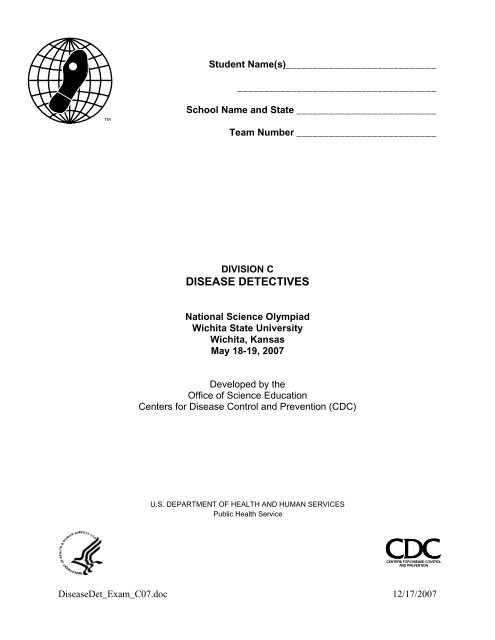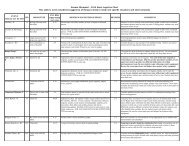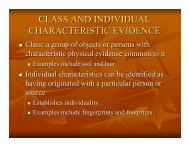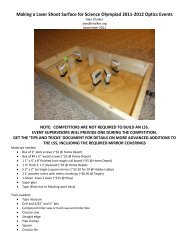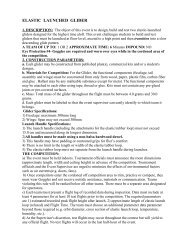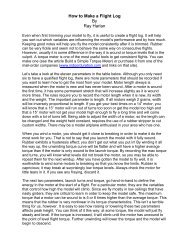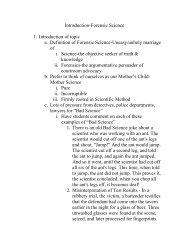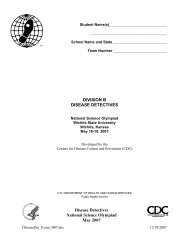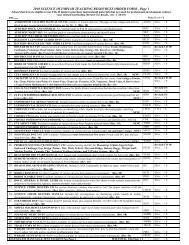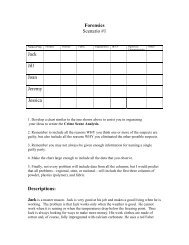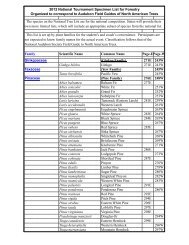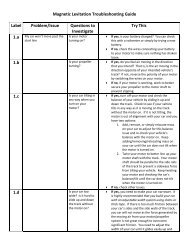DISEASE DETECTIVES - Science Olympiad
DISEASE DETECTIVES - Science Olympiad
DISEASE DETECTIVES - Science Olympiad
Create successful ePaper yourself
Turn your PDF publications into a flip-book with our unique Google optimized e-Paper software.
Student Name(s)____________________________<br />
_____________________________________<br />
School Name and State __________________________<br />
Team Number __________________________<br />
DIVISION C<br />
<strong>DISEASE</strong> <strong>DETECTIVES</strong><br />
National <strong>Science</strong> <strong>Olympiad</strong><br />
Wichita State University<br />
Wichita, Kansas<br />
May 18-19, 2007<br />
Developed by the<br />
Office of <strong>Science</strong> Education<br />
Centers for Disease Control and Prevention (CDC)<br />
U.S. DEPARTMENT OF HEALTH AND HUMAN SERVICES<br />
Public Health Service<br />
DiseaseDet_Exam_C07.doc 12/17/2007
This event includes 3 Problems;<br />
Problem I: <strong>DISEASE</strong> <strong>DETECTIVES</strong> TACKLE ENVIRONMENTAL HEALTH<br />
Total Suggested time = 10 minutes<br />
Public perceptions of environmental health often are only that it relates to illnesses due to chemical<br />
exposures from pollution. This is only a small part of the environmental disease detectives’ role.<br />
Environmental health is the promotion of health and quality of life by preventing or controlling diseases<br />
that result from interactions between people and their environment. Almost every disease could be<br />
considered to be caused by either environmental factors or genetic factors. Disease detectives consider<br />
environment very broadly. The human environment is the air we breathe, the water we drink, the food we<br />
eat, the climate surrounding us, and the space we live in.<br />
1. (2 pts) The environment is one component of a famous triad in epidemiology. List the other two<br />
components of that triad.<br />
• Agent<br />
• Host<br />
2. (2 pts) Individual characteristics of people, such as age, may modify the effects of environmental<br />
exposures. List 2 of these that disease detectives need to think of in planning investigations.<br />
Answers will vary but may include<br />
• Genetic (genes)<br />
• Diet (nutrition)<br />
• Gender<br />
• Physical Condition<br />
• Other diseases (Underlying diseases)<br />
Environmental epidemiology studies often deal with specific factors which can be measured quantitatively<br />
as either an exposure or a dose. When the factor is a chemical, exposure can be estimated and dose<br />
determined by measuring the chemical in blood or tissue. For many environmental factors there may be a<br />
range of effects from subtle biochemical changes to severe illness<br />
3. (1 pt) What is this relationship between dose and severity of illness called?<br />
• Dose Response<br />
This relationship is important in environmental epidemiology because it can provide a foundation for<br />
safety standards that state or federal government officials can be used to decide which health effects should<br />
be prevented.<br />
4. (1 pt) Name a U.S. government agency that might use environmental epidemiology to set air or<br />
water quality standards?<br />
• Environmental Protection Agency (EPA or USEPA)<br />
DiseaseDet_Exam_C07.doc 2<br />
12/17/2007
Public environmental health problems usually are of two types: they come to our attention because<br />
concerns about illnesses, or they arise from potential exposure situations. Procedures to evaluate<br />
environmentally caused diseases follow the same basic principles as used in communicable disease studies.<br />
Some diseases caused by micro-organisms such as bacteria or viruses can also be considered<br />
environmentally related diseases.<br />
5. (3 pts) Name 3 routes of entry into a person’s body for environmental micro-organisms or<br />
chemicals .<br />
• Respiratory (breathing or through the air)<br />
• Ingestion (food, eating, water or drinking)<br />
• Dermal Contact (skin or skin absorption<br />
6. (3 pts) Environmental factors that can cause disease could be biological, chemical, or physical.<br />
List one of each type. (No credit if you list agents discussed in today’s event)<br />
Answers will vary but may include<br />
Biological:<br />
• Bacteria or parasites or viruses (Specific genus/species of specific organism or virus<br />
name is acceptable<br />
Chemical:<br />
• Drugs<br />
• Dust<br />
• Skin irritants<br />
• Food additives<br />
• Food contaminants<br />
• Hazardous waste<br />
• Toxic waste<br />
• Pollution<br />
Physical:<br />
• Noise<br />
• Climate<br />
• Weather<br />
• Light<br />
DiseaseDet_Exam_C07.doc 3<br />
12/17/2007
Problem II. <strong>DISEASE</strong> <strong>DETECTIVES</strong> TRACK DOWN THE KILLER OF LEGIONS<br />
Total Suggested time = 25 minutes<br />
Fig 1. Covers from Magazines Featuring Articles on the Outbreak of Legionnaires<br />
Disease in Philadelphia, Summer 1976 (CDC Public Health Image Library)<br />
The year 1976 marked the 200 th anniversary of the signing of the Declaration of Independence and the start<br />
of a new era in public health – the era of emerging infectious diseases. There was widespread concern<br />
about the isolation of a strain of influenza virus from a soldier who died from the disease in Fort Dix, New<br />
Jersey in early February. The virus was similar to that responsible for the great pandemic in 1918 and in<br />
March President Gerald Ford announced a $135 million plan to immunize Americans against the so-called<br />
“swine flu”. The health care and public health communities were on the alert for cases of severe<br />
respiratory illness that would suggest the start of a pandemic.<br />
It was in this setting that the American Legion Auxillary, Department of Pennsylvania held its 56 th annual<br />
convention in Philadelphia, Pennsylvania on July 21-24th. Within 2 days of the start, a number of<br />
attendees became ill with severe pneumonia – ultimately 221 persons became ill and 34 persons died of<br />
what is now known as “Legionnaires’ disease”. The first death took place on Saturday, July 24.<br />
7. Legionnaires' disease is caused by a bacterium while influenza is caused by a virus.<br />
a. (1 pt) Which of the above types of pathogen is most likely to multiply in the environment?<br />
• Bacteria<br />
b. (1 pt) Which of the above diseases is most likely to be spread from person-to-person?<br />
• Influenza<br />
By mid-day Monday, July 26th, 11 persons had died. Disease Detectives from the CDC and Pennsylvania<br />
Department of Health were notified of a possible outbreak of pneumonia among Legionnaires attending<br />
the convention in Philadelphia.<br />
DiseaseDet_Exam_C07.doc 4<br />
12/17/2007
The Pennsylvania Medical Society, Pennsylvania Osteopathic Association and Hospital Association of<br />
Pennsylvania were notified of a potential statewide epidemic of pneumonia. Public health nurses searched<br />
hospitals in their areas for possible cases.<br />
8. (24 pts) Describe two groups of cases likely to be missed by the above case-finding.<br />
Answers will vary but may include:<br />
• Persons who did not seek medical attention<br />
• Persons who sought medical attention outside Pennsylvania<br />
• Persons who did not become ill<br />
• Persons who developed symptoms other than pneumonia<br />
The public was invited to report possible cases via a telephone hot line and news reports were searched for<br />
additional cases and a series of at least 8 different surveys were conducted in order to identify additional<br />
cases. One of these included a survey of a random sample of guests registered in four Philadelphia hotels<br />
during the period from July 6 - August 7, 1976.<br />
Table 1. Illness resembling Legionnaires' disease in random sample of guests in four Philadelphia hotels<br />
according to week of registration, July 6 - August 7, 1976.<br />
Week of Registration<br />
Hotel July 6-10 July 11-17 July 18-24 July 25-31 August 1-7<br />
A 0/142/155 * 0/130/159 15/180/200 0/106/152 0/88/147<br />
B - - 5/144/200 - -<br />
C - 1/70/85 2/100/160 0/95/140 0/78/160<br />
D - 1/90/151 1/84/150 0/92/151 9/58/154<br />
*<br />
Number ill/number interviewed/number selected for survey<br />
9. Using the data in Table 1, calculate the relative risk of illness resembling Legionnaires' disease for<br />
each of the above 4 hotels for the week of July 18-24. (show your work in the spaces below)<br />
a. Hotel A (2 pts)<br />
• Incidence = (15/180) * 100 = 8.3<br />
• Relative Risk = 8.3/1.2 = 6.9<br />
b. Hotel B (2 pts)<br />
• Incidence = (5/144) * 100 = 3.5<br />
• Relative Risk = 3.4/1.2 = 2.9<br />
c. Hotel C (2pts)<br />
• Incidence = (2/100) * 100 = 2.0<br />
DiseaseDet_Exam_C07.doc 5<br />
12/17/2007
• Relative Risk = 2.0/1.2 = 1.7<br />
d. Hotel D (2pts)<br />
• Incidence = (1/84) * 100 = 1.2<br />
• Relative Risk = Referent Group<br />
Note: Hotel D serves as the referent group and serves as the denominator for calculating the<br />
relative risk for the other hotels<br />
Figure 2: Number of cases of Legionnaires disease and Broad Street pneumonia by date of onset.<br />
Figure 2 shows the number of cases of Legionnaires disease and of another condition, Broad Street<br />
pneumonia, by date of onset. Persons with Broad Street pneumonia had illness similar to the attendees of<br />
the American Legion convention. These persons did not attend the American Legion convention or enter<br />
Hotel A but were within one block of Hotel A between July 1 and the onset of their illness. Hotel A is<br />
located on Broad Street.<br />
10. (1 pt) What term do Disease Detectives use for the graph in Figure 1?<br />
Epidemic curve or epi curve<br />
11. (1 pt) Based on the shape of the curve for Legionnaires’ disease, what type of epidemic source<br />
(point source or person-to-person) is represented in Figure 1?<br />
Point source<br />
12. The Philadelphia outbreak is the second time that “Broad Street” appears in the epidemiologic<br />
literature. The first “Broad Street” is in another city/country and was associated with another<br />
disease and an outbreak that is considered to be the start of the field of epidemiology.<br />
DiseaseDet_Exam_C07.doc 6<br />
12/17/2007
a. (1 pt) Where (what city/country) was the first Broad Street?<br />
London, England<br />
b. (1 pt) What was the disease under investigation in the first outbreak?<br />
Chlorea<br />
c. (1 pt) Who was the person who investigated the first outbreak?<br />
John Snow<br />
13. (2 pts) Returning to the Philadelphia outbreak, what do these Broad Street pneumonia cases tell<br />
you about the possible exposures to the agent and the risk for disease?<br />
The source of exposure was associated with the hotel, but illness was not confined to people<br />
who only stayed at the hotel<br />
Disease detectives conducted a number of investigations on the possible mode of transmission. One of<br />
these included an interview of 59 persons who were roommates of Legionnaires’ disease case patients<br />
while they were at the convention and 69 roommates of 68 control Legionnaires. Five of the 59<br />
roommates of Legionnaires’ disease cases and 5 of 69 roommates of controls were ill with Legionnaires’<br />
disease.<br />
14. (2 pts) Calculate the relative risk of illness among roommates of Legionnaires’ disease cases<br />
(show your work in the space below)<br />
Relative Risk = (5/59)/(6/69) = 0.97<br />
On August 17, 24 days after the end of the convention, disease detectives interviewed 193 family contacts<br />
of persons with Legionnaires disease and 209 family contacts of well attendees. None of these persons had<br />
Legionnaires-like illness after the convention.<br />
15. (1 pt) What does this suggest about the likelihood of person-to-person transmission?<br />
Person to person transmission from these cases is not very likely.<br />
Five months after the outbreak, disease detectives interviewed 56 Legionnaires who became ill and<br />
survived their illness and 56 control persons, matched with the cases by age, who had not become ill. One<br />
of the questions asked dealt with smoking at the convention. The results of that investigation are shown in<br />
Table 2.<br />
Table 2 History of cigarette smoking among Legionnaires’ disease among matched case and control pairs<br />
at the American Legion Convention, Philadelphia, July, 1976<br />
DiseaseDet_Exam_C07.doc 7<br />
12/17/2007
Controls<br />
Cases Smoker Nonsmoker Total<br />
Smoker 14 17 31<br />
Nonsmoker 5 16 21<br />
19 33 52<br />
16. (1 pt) What term do Disease Detectives use for the study design?<br />
Matched case-control study<br />
17. (4 pts) Calculate the odds ratio or relative risk (whichever is appropriate) for illness associated<br />
with smoking at the convention (Show your work in the space below – carry answer to 2 decimal<br />
places).<br />
Max likelihood = 17/5 = 3.4<br />
Investigations of 28 area restaurants and bars and the two main Legionnaires events where food was served<br />
failed to demonstrate and association between illness and food consumption. Disease detectives studied<br />
the association between alcohol or water consumption and illness. Although no association was found<br />
between alcohol consumption and illness, 45 of 69 ill delegates drank water as compared to 469 of 976<br />
well delegates.<br />
18. (2 pts) Calculate the odds ratio of illness associated with water consumption. (Show your work in<br />
the space below).<br />
Odds Ratio = (45 * 507)/(24 * 469) = 2.02<br />
DiseaseDet_Exam_C07.doc 8<br />
12/17/2007
Problem II. <strong>DISEASE</strong> <strong>DETECTIVES</strong> INVESTIGATE AN OUTBREAK OF<br />
ACCIDENTAL POISONING<br />
Total Suggested time = 15 minutes<br />
Acute renal failure is a serious medical condition in which the kidneys (the organ responsible for<br />
eliminating toxic substances from the body) either function poorly or not at all. The condition is<br />
life threatening without prompt medical attention. Acute renal failure can be due to underlying<br />
illnesses, or can be caused by infections or ingesting certain chemicals. Kidney function can be<br />
assessed by measuring the level of a creatinine in a patient’s blood. Levels of 1.5 mg/dl<br />
(milligrams per deciliter) or higher indicate impaired kidney function.<br />
In September 2006, a physician at a hospital in the Republic of Panama reported to health<br />
officials that he had noticed an unusual number of older men that all developed unexplained, newonset<br />
acute renal failure as well as some different neurological symptoms. Upon reviewing some<br />
of the hospital’s medical charts and records, health care officials noticed that a few persons with<br />
these symptoms actually had presented to the hospital as far back as June of 2006. Some patients<br />
complained of different types of gastrointestinal symptoms such as nausea, stomach pain, and/or<br />
diarrhea when they first presented to the hospital. These symptoms were either accompanied by<br />
or followed very shortly thereafter in all cases by oliguria or anuria (decreased or absent urine<br />
production). Loss of appetite and fatigue were also found among many of the patients. Many<br />
patients also typically developed unusual neurological signs a few days later. These were variable<br />
between patients and included weakness in the muscles of the face, weakness of the arms and<br />
legs, and encephalopathy (severe confusion and inability to respond). Twelve (57%) of twentyone<br />
patients had died. Patients presenting to this hospital with these symptoms typically had<br />
creatinine levels of 10 mg/dl or higher. About two months before the outbreak, the hospital<br />
system added the new drug lisinopril for hypertension to its pharmacy. Physicians noticed that<br />
some of the sick patients had been taking this new drug. One side effect of this type of<br />
DiseaseDet_Exam_C07.doc 9<br />
12/17/2007
medication is a dry cough. Some patients brought their medications with them to the hospital,<br />
which included bottles of a prescription cough syrup. Health authorities suspected that<br />
contamination of one of these medications may have been causing the illness.<br />
1. (2 pts) List two sources of information investigators could use to identify additional cases of acute<br />
renal failure in this community?<br />
Answers will vary but may include<br />
• Hospital admission data from other hospitals<br />
• Hemodialysis clinics<br />
• Private nephrologists (kidney physician specialist) offices<br />
• Local public health authorities<br />
• Outpatient clinics<br />
• Local health departments<br />
• Regional epidemiologists<br />
• Private doctors<br />
2. (2 pts) How could investigators show that this was an unusual occurrence for this hospital?<br />
• Compare incidence of new onset acute renal failure in the population to national,<br />
historical normal rates as well as rates diagnosed at comparable local hospitals<br />
• Review records and compare current information to historical information<br />
Investigators identified a total of 42 cases of acute renal failure and designed a matched case-control study<br />
utilizing patients within the hospital.<br />
3. (4 pts) Write a concise and specific case definition for the case- control study.<br />
• Unexplained acute renal failure in a person occurring in June 2006 or later with<br />
oliguria/anuria and creatinine >= 1.5 mg/dL<br />
4. (2 pts) Explain briefly why investigators matched controls to cases by gender.<br />
• Most cases were men<br />
• Statistical efficiency<br />
Note: No credit for<br />
• To study gender-specific associations<br />
• To control confounding<br />
DiseaseDet_Exam_C07.doc 10<br />
12/17/2007
5. (2 pts) Besides the possible exposures already identified, name two other possible exposures you<br />
would want to include in your questionnaire.<br />
Answers will vary but may include<br />
• Other medications including over the counter products and folk remedies<br />
• Social habits (i.e. smoking, alcoholic beverages, recreational activities that might identify a<br />
sub-group with a particular exposure)<br />
• Dietary patterns including water source<br />
• Additional medications<br />
• Possible infectious exposures (food, animals)<br />
• Pesticides<br />
• Tobacco<br />
A total of 42 case-patients and 140 control-patients were enrolled in the case-case control study. Date of<br />
onset of acute renal failure for case-patients is shown below.<br />
30<br />
25<br />
20<br />
No. of Cases<br />
15<br />
10<br />
5<br />
0<br />
7/2-7/8<br />
7/9-7/15<br />
7/16-7/22<br />
7/23-7/29<br />
7/30-8/5<br />
8/6-8/12<br />
8/13-8/19<br />
8/20-8/26<br />
8/27-9/2<br />
9/3-9/9<br />
9/10-9/16<br />
9/17-9/23<br />
9/24-9/30<br />
10/1-10/7<br />
10/8-10/14<br />
10/15-10/21<br />
Week of Onset of Symptoms<br />
Figure 1. Number of cases of acute renal failure in Panama, by week of onset of symptoms, July 2 through<br />
October 21, 2006.<br />
6. (1 pt) What do disease detectives call this type of histogram?<br />
Epidemic curve (epi curve)<br />
DiseaseDet_Exam_C07.doc 11<br />
12/17/2007
Table 1. Associations between potential risk factors and onset of acute renal failure syndrome<br />
among case- and control-patients, Panama, 2006.<br />
Cases<br />
(n=42)<br />
Controls<br />
(n=140)<br />
No. % No. %<br />
Used cough syrup<br />
yes 17 40.5 4 2.9<br />
no 25 59.5 136 97.1<br />
Used any ACE<br />
inhibitor<br />
yes 26 61.9 34 24.3<br />
no 16 38.1 106 75.7<br />
7. (4 pts) Calculate odds ratios for use of cough syrup and ACE inhibitors. Show all work.<br />
Cough Syrup:<br />
Odds Ratio: (17 * 136)/(25 * 4) = 23.12<br />
Used any ACE inhibitor:<br />
Odds Ratio: (26 * 106)/(16 * 34) = 5.07<br />
8. (2 pts) What proportion of cases used both cough syrup and any ACE inhibitors?<br />
Cannot determine from data provided<br />
DiseaseDet_Exam_C07.doc 12<br />
12/17/2007
The CDC environmental health laboratory analyzed medications provided by case-subjects for the<br />
presence of contaminants and identified the presence of diethylene glycol, or DEG, in the cough syrup.<br />
DEG is known to be toxic to the renal system and can cause acute renal failure.<br />
9. (4 pts) In light of the laboratory findings, explain the role each of these medications played in the<br />
exposure-disease relationship.<br />
Both the odds ratios are elevated, however, the cough syrup is extremely high and was validated as<br />
being contaminated by the lab. It is likely that the elevated odds ration for e thecae inhibitors is due to<br />
the fact that those using ace inhibitors were also using the cough syrup because we know lisinopril<br />
causes a dry, irritating cough. (see case introduction) So although the lisinopril is causative, it is only<br />
through its association with the cough syrup. In other words, ace inhibitors confounded the exposuredisease<br />
relationship.<br />
Investigators informed health officials of these findings. The cough syrup was manufactured by a local<br />
Panamanian pharmaceutical company which used glycerin as one ingredient in its cough syrups. Further<br />
laboratory work identified DEG in a single lot of glycerin that had been imported to Panama from China.<br />
10. (1 pt) Describe an immediate intervention that health officials would most likely have done based<br />
on this new information.<br />
Answers will vary but may include<br />
• National medication recall of all suspected contaminated medication<br />
• Shut down the manufacturing facility<br />
• Recall the cough syrup through public announcement on the radio, in newspapers, etc.<br />
An outbreak similar to this occurred in United States in 1937, in which 105 people died. This led<br />
to the passage of the 1938 Federal Food, Drug, and Cosmetic Act, which gave the Federal Food<br />
and Drug Administration extended authority to regulate and oversee pre-market evaluation and<br />
safety testing of new drugs sold in the United States. Although there have been no subsequent<br />
outbreaks of DEG poisoning in the United States, there have been at least nine other outbreaks in<br />
developing countries.<br />
DEG is used in automotive anti-freeze products. DEG is not normally used in preparing medications.<br />
However, since DEG has a sweet taste, its presence in medication would not be easily detected by<br />
consumers.<br />
Sci Oly C Stud-ver4-may11.doc<br />
DiseaseDet_Exam_C07.doc 13<br />
12/17/2007


